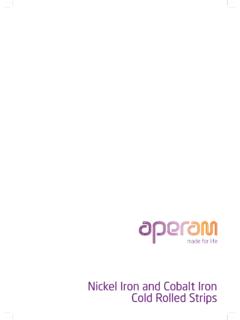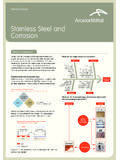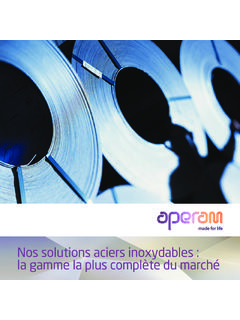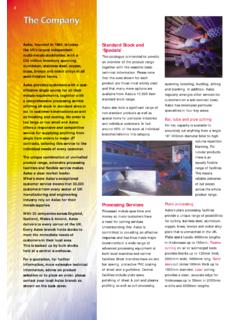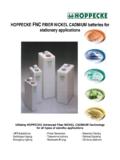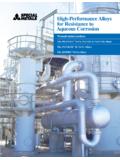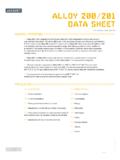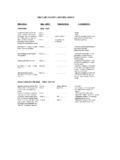Transcription of THE FERRITIC STAINLESS STEEL FAMILY: THE …
1 THE FERRITIC STAINLESS STEEL family : THE appropriate . ANSWER TO nickel volatility ? J. Charles1, Mithieux2, Santacreu2, L. Peguet2. 1. ArcelorMittal STAINLESS , France, 2 ArcelorMittal R&D, France Abstract Due to recent nickel price volatality, FERRITIC STAINLESS steels having no or very low nickel content can be very interesting to STAINLESS steels users. Although ferrite is the most common structure in STEEL , it represents only about 26% of the total STAINLESS STEEL production nowadays. The paper presents the FERRITIC STAINLESS STEEL family : mechanical properties of the grade including drawability as well as corrosion resistance properties. Experimental data of the newly developed 20% Cr FERRITIC grade are discussed and compared to the properties of existing 200 and 300 series grades. High temperature properties of FERRITIC STAINLESS steels designed for exhaust systems are also presented.
2 Introduction STAINLESS steels are STAINLESS ' because their chromium content minimum gives them remarkable resistance to wet corrosion and high temperature oxidation. FERRITIC grades, containing only chromium and possibly other elements (Mo, Ti, Nb, etc.), are well known as cost savings materials since most of them have no expensive nickel additions. Furthermore, the chromium content can be optimized taking into account a very wide range of applications: from to 29%. Chromium content of austenitic grades is generally kept in the 17-18% range because of austenitic phase stability considerations (lower or increased Cr content in 300-series austenitic grades requires further increase of expensive Ni to stabilize the austenitic phase). Standard FERRITIC grades such as 409, 410 and 430 are readily available all over the world. Very successfully used in important applications, such as washing-machine drums and exhaust systems, they actually have much broader application potential, in numerous fields.
3 More recently developed FERRITIC grades, such as 439 and 441 meet an even wider range of requirements. They can be formed into more complex shapes and joined using most conventional joining methods, including welding. In material selection decisions, these grades are often weighed against 304 austenitic grades. The addition of molybdenum enhances the resistance of FERRITIC STAINLESS steels to localised corrosion (434, 436). Grade 444 is even considered at least equal to austenitic grade 316 in most of the cases when considering corrosion resistance properties. Superferritic grades have also been developed since many years. Their very high chromium content (25-29%) with additional Ni and Mo alloying make them well-known highly corrosion resistant products albeit restricted to marginal applications. This is due to their high sensitivity to embrittling phase transitions.
4 Recently, newly developed FERRITIC grades with the aim to replace 304 austenitic grades have been introduced into the market. Their chromium content lies in the 20-22% range and they are free of expensive nickel or molybdenum additions. The grades are stabilized by minor additions of Ti/Nb/Cu. H02-1. The recent volatility of Ni has brought the 400 series under the spotlights. A key note lecture devoted to new developments, properties and applications of FERRITIC grades seemed to be more than welcome in the scientific program of the STAINLESS STEEL Science and Market 2008, Helsinki international conference. STAINLESS Families and Alloying Costs ISSF data Figure 1. Schaeffler diagram Figure 2. Market share of various STAINLESS STEEL families Although the Schaeffler diagram (Figure 1) is mainly used for welded structures, it is very useful to illustrate the different areas of stability of STAINLESS STEEL microstructures.
5 The classical austenitic grades the so called 300 series contain generally 8-10% Ni while the more (Cr and Mo) alloyed grades require even more Ni to stabilise the austenitic phase. The most popular STAINLESS STEEL 304. is one of the lowest alloyed grades of the austenitic area (not including nitrogen alloyed grades). 316 grade having 2% Mo content is considered as the standard alloyed austenitic STAINLESS STEEL for corrosion resistance properties. Until 2003, austenitic grades 304 and 316 represented together about 70% of the total STAINLESS STEEL production. (Figure 2). With the extreme volatility of alloying element costs, new grades have recently been introduced in the market. (Figures 3 to 6) These grades are also austenitic grades, but with partial replacement of Ni by combined Mn and N additions. Their share in STAINLESS STEEL production has recently increased to more than 10%.
6 The Asian market is particularly involved in this booming development. A paper about the recent developments of the 200 series in general and the introduction of a particular 200 series grade (with VDEh designation ) is presented at this conference too. The grade is designed to feature nearly equivalent properties to the 304 grade.(1). 52 000 $/T 04/2007. Chromium Evolutions LME Ni Evolutions $/lb 34 000 $/T. $/lb 29 000 $/T. 09/2007. $/lb 24 000 $/T. $/lb 19 000 $/T. $/lb 14 000 $/T. $/lb $/lb 9 000 $/T. $/lb 4 000 $/T. 02 03 04 05 06 02 03 04 05 06. Figure 3. Cr and Ni price evolution in latest years H02-1. 2%1%. 11%. 304. 316. 7% >Mo AUST. 200 OLD. 200 NEW. 11% 12CR FERR. 58%. 17CR FERR. 1% Mo FERR. 1%. DUPLEX. 8%. Figures 4 and 5. STAINLESS worldwide crude production in 2004 by grades. Another family is also growing, particularly for the most severe corrosion resistance applications: the duplex grades.
7 Despite their very attractive features combining high mechanical properties with corrosion resistance they still account for less than 1% of the total STAINLESS STEEL production. More recently, the development of the lean duplex grades and duplex cold rolled products were introduced. This may have a significant effect on duplex growth in the near future. FERRITIC STAINLESS appears to be the most effective answer to nickel volatility . Their market share has grown in the recent past and they represent already about 30% of total STAINLESS STEEL production. They represent a significant cost saving advantage. Moreover, many grades have been developed in order to optimize corrosion resistance or mechanical properties. Because of welding aspects and toughness properties, they are mainly restricted to thinner gauges even if they often show cost saving potential (Figure 6).
8 They cover a very wide area of applications. 8000 304L. 316L. 7000 Ni Mo Cr 2101. 1 6 7 0,8 2304. 6000. 2 10 17 1 2205. 5000 3 14 35 1,5 2507. 430. 4 30 40 1,5. 4000 439. 5 52 42 1,5. 445. 3000 434. 444. 2000. 201. 1000 204. 17 5 Cu 0 15 1 Cu 1 2 3 4 5. Figure 6. Raw material cost models (real figures observed from 2004 to2007). The FERRITIC grades FERRITIC grades may be classified into five groups three families of standard grades and two of special grades. By far the greatest current use of ferritics, both in terms of tonnage and number of applications, is centered around the standard grades (Figure 7). Table 1 presents the chemical composition of the most relevant FERRITIC STAINLESS steels. H02-1. Figure 7. FERRITIC STAINLESS steels families Group 1: 10-14% Cr (type 409/410L) has the lowest chromium content of all STAINLESS steels. Figures 8 and 9 present the effects of Cr, Ni and C/N alloying on phase stability.
9 Clearly the stable austenite domain ( gamma loop ) which is observed around 1000-1200 C is extended by nickel or carbon (or nitrogen) additions while chromium additions stabilize the FERRITIC phase. As a result, STAINLESS STEEL with a minimum of 13% Cr, no Ni and extra low interstitial elements (C/N) may present a fully FERRITIC structure at all temperatures. Figures 8 and 9. Fe-Ni-Cr and Fe-Cr-C phase diagrams. When reducing Cr and/or increasing C+N, the grade, when heated, undergoes a ferrite/austenite transformation. Grain refining treatments can be performed and the grades having a stable austenitic loop may undergo martensitic transformation when quenched to room temperature. Several investigators have studied the influence of alloying elements on the Ms temperature (4,5,6).. In the case of 12% Cr steels, table 1 gives the change in Ms per weight percent of element added, the value for the base alloy being 300 C.
10 Table 1 also presents the effect of alloying elements on the Ac1 temperature (temperature at which the austenite starts to form on heating). C and N appear to have no significant effect on Ac1 temperature in 12% Cr grades. Table 1. Effects of alloying elements on the Ac1 and Ms temperatures of 13% Cr FERRITIC steels. Element C Mn Mo Cr Ni W Si Change in Ms ( C). -475 -33 -21 -17 -17 -11 -11. per % addition Ni Co Si C Al Mo V. Change in Ac1( C). -30 -25 -5 0 30 35 50. per % addition H02-1. The mechanical properties of 12-13% Cr alloys are closely related to the carbon and nitrogen contents. This is particularly the case for quenched products from the gamma loop. Figure 10. shows hardness values obtained on austenitized 13% Cr samples, oil quenched at 0 C and stress relieved at 200 C. Figure 10. Effects of carbon content on mechanical properties of 13% Cr STAINLESS after water quenching and 200 C stress relieving heat treatment.

